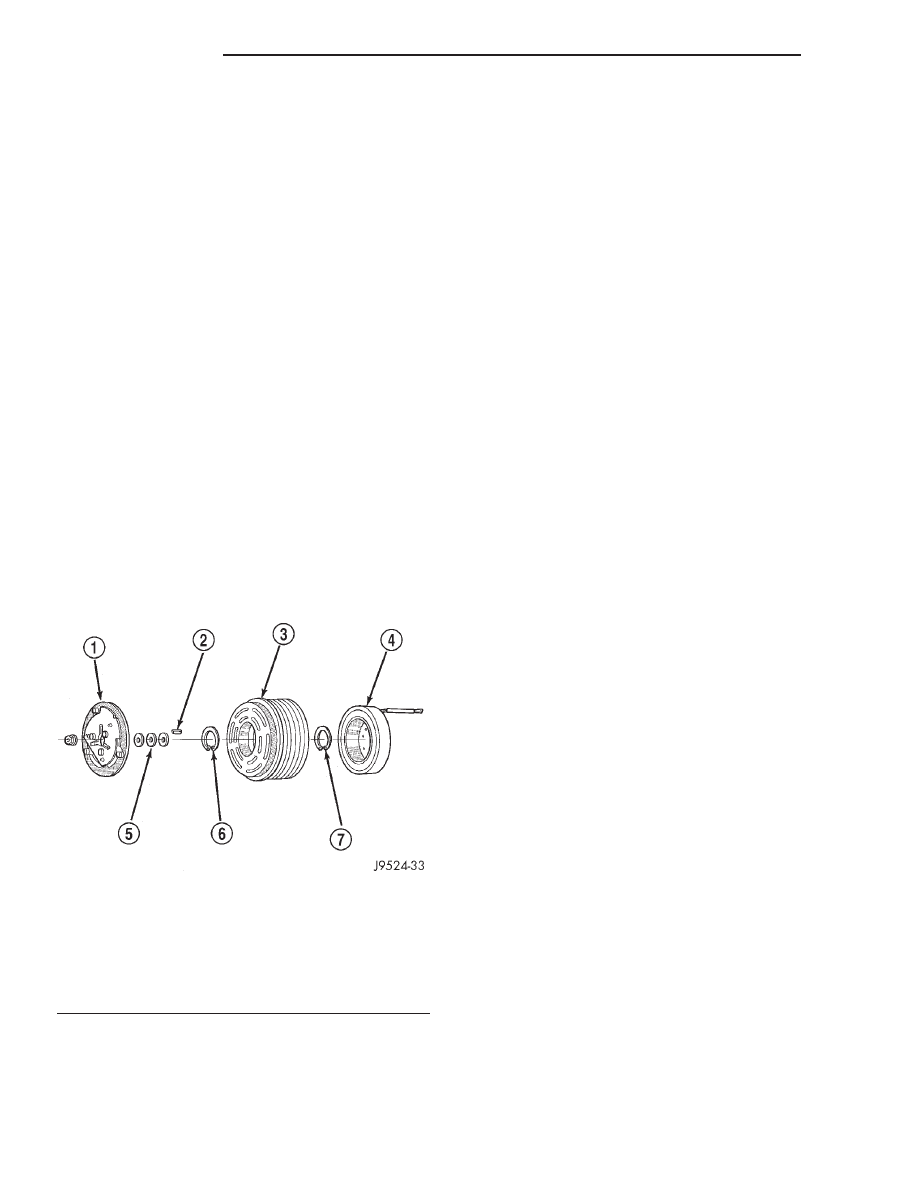Dodge Dakota (R1). Manual - part 791

OPERATION
The high pressure relief valve vents the system when
a discharge pressure of 3445 to 4135 kPa (500 to 600
psi) or above is reached. The valve closes with a mini-
mum discharge pressure of 2756 kPa (400 psi) is
reached.
The high pressure relief valve vents only enough
refrigerant to reduce the system pressure, and then
re-seats itself. The majority of the refrigerant is con-
served in the system. If the valve vents refrigerant, it
does not mean the valve is faulty.
The high pressure relief valve is a factory-cali-
brated
unit.
The
valve
cannot
be
adjusted
or
repaired, and must not be removed or otherwise dis-
turbed. The valve is only serviced as a part of the
compressor assembly.
A/C COMPRESSOR CLUTCH
DESCRIPTION
The compressor clutch assembly consists of a station-
ary electromagnetic coil, a hub bearing and pulley
assembly, and a clutch plate (Fig. 1). The electromag-
netic coil unit and the hub bearing and pulley assembly
are each retained on the nose of the compressor front
housing with snap rings. The clutch plate is mounted to
the compressor shaft and secured with a nut.
OPERATION
The compressor clutch assembly provides the
means to engage and disengage the compressor from
the engine serpentine accessory drive belt. When the
clutch coil is energized, it magnetically draws the
clutch into contact with the pulley and drives the
compressor shaft. When the coil is not energized, the
pulley freewheels on the clutch hub bearing, which is
part of the pulley. The compressor clutch and coil are
the only serviced parts on the compressor.
The compressor clutch engagement is controlled by
several components: the a/c heater mode control
switch, the a/c loss of charge switch, the a/c pressure
transducer, the compressor clutch relay, the evapora-
tor temperature sensor and the Powertrain Control
Module (PCM). The PCM may delay compressor
clutch engagement for up to thirty seconds (Refer to
8 - ELECTRICAL/ELECTRONIC CONTROL MOD-
ULES/POWERTRAIN
CONTROL
MODULE
-
DESCRIPTION).
DIAGNOSIS AND TESTING - A/C COMPRESSOR
CLUTCH COIL
For circuit descriptions and diagrams, (Refer to
Appropriate Wiring Information). The battery must
be fully-charged before performing the following tests
(Refer to 8 - ELECTRICAL/CHARGING - DIAGNO-
SIS AND TESTING).
(1) Connect an ammeter (0 to 10 ampere scale) in
series with the clutch coil terminal. Use a voltmeter
(0 to 20 volt scale) with clip-type leads for measuring
the voltage across the battery and the compressor
clutch coil.
(2) With the a/c select button depressed, and the
blower motor switch in the lowest speed position,
start the engine and run it at normal idle.
(3) The compressor clutch coil voltage should read
within 0.2 volts of the battery voltage. If there is
voltage at the clutch coil, but the reading is not
within 0.2 volts of the battery voltage, test the clutch
coil feed circuit for excessive voltage drop and repair
as required. If there is no voltage reading at the
clutch coil, use a DRB III
t scan tool and (Refer to
Appropriate Diagnostic Information) for testing of the
compressor clutch circuit. The following components
must be checked and repaired as required before you
can complete testing of the clutch coil:
• Fuses in the junction block and the Power Dis-
tribution Center (PDC)
• A/C Heater Control
• Compressor Clutch Relay
• A/C Pressure Transducer
• A/C Loss of Charge Pressure Switch
• Evaporator Temperature Sensor
• Powertrain Control Module (PCM)
(4) The compressor clutch coil is acceptable if the
current draw measured at the clutch coil is 2.0 to 3.9
amperes with the electrical system voltage at 11.5 to
12.5 volts. This should only be checked with the work
area temperature at 21° C (70° F). If system voltage
Fig. 1 COMPRESSOR CLUTCH - TYPICAL
1 - CLUTCH PLATE
2 - SHAFT KEY
3 - PULLEY
4 - COIL
5 - CLUTCH SHIMS
6 - SNAP RING
7 - SNAP RING
24 - 10
CONTROLS
AN
A/C COMPRESSOR HIGH PRESSURE RELIEF VALVE (Continued)